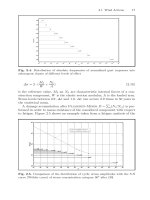Deck structural design
Bạn đang xem bản rút gọn của tài liệu. Xem và tải ngay bản đầy đủ của tài liệu tại đây (101.7 KB, 4 trang )
D
eck Structural Design
OVERVIEW
Introduction
Now that you have the conceptual design for your deck, and you plan on doing this on your own, it is time to
develop the structural elements and material specifications. No matter if you complete the project yourself or
hire a contractor, this exercise will help you to get an understanding of the details of your deck. These
specifications will be a part of the Construction Document you will either take to the building department for a
permit, use to get bids on the project or use to build the deck yourself.
You might have already begun thinking about the construction details and possibly have a pretty good idea of
the components that make up a deck or have some good questions. And, unless you have special conditions, we
will answer most of those questions here. Special conditions include steep slopes, unstable soil and specific
building codes. If you are unsure where your project fits, check with a contractor or the building department.
After you complete this tutorial, you will have a better idea whether to do-it-yourself or hire a contractor. So,
grab your sketches and here we go.
• Beginner - 3 to 4 hours
• Intermediate - 2 to 3 hours
• Advanced - 1 to 2 hours
Saving money by scrimping on materials or crowding the design tables will come back
on you when the deck begins to age. Pay more now to save in the future.
If you put this project out to bid, the estimates will be more "apples-for-apples" if the
contractors have a detailed plan to bid from. The Construction Document you are creating here will help
make this possible.
Determine the direction the deck boards will run, this will influence the layout of the joists
and girders. Most deck boards run parallel with the long dimension of the deck.
Print out the Deck Spec and Materials list, which you can fill out in the following steps.
STEPS
1. Create a list: Fill in the blanks on the Deck Specs form. This information
will give you the basis for completing the materials list. You should get the
measurements from the conceptual plan created in the previous tutorial.
The following steps will help you fill in the quantities for each item. When
this list is complete, you will be able to set a budget for your deck project by
getting an estimate from the lumberyard or putting the project out to bid.
Make your own copy of this list and let's begin.
2. Estimate the ledger: Measure from your plans how many feet of wall will
support the deck and add 10% for waste. Note: Always add a "waste
factor," use 10% as a minimum.
3. Estimate concrete: This project calls for concrete pads measuring 18
inches by 18 inches by 12 inches deep. That equals 2.25 cubic feet per pad,
times the number of pads to figure the total cubic feet. Verify the standard
in your area, as many areas, especially in colder climates, require deeper
pads. The goal is to have concrete pads that extend below the frost line,
which could be as deep as 42". For each set of stairs add 2 cubic feet to
support the bottom of the stairs. Don't forget to add the 10% to the total
for waste; and, there are 27 cubic feet in a cubic yard.
Our 30 foot by 20 foot deck will have three rows of concrete pads with five
pads in each row 15 concrete pads times 2.25 cubic feet (c.f.) equals 33.75
c.f. plus 2 c.f. for a total of 35.75 c.f. Don't forget the 10% waste factor. For
this deck we will order 37.125 c.f. Be sure to round up to the nearest
le quantity.
availab
4. Estimate concrete piers: Simply count the number of concrete pads; you
will need a concrete pier for each pad. It is not necessary to include a waste
factor for piers.
5. Estimate posts: You will need posts if your deck is over 18 inches above
the ground. Count the number of concrete pads and multiply that number
by the average height of the deck above the ground. Take care that the
individual post heights fall evenly into a common 4x4 lengths; 4x4's come in
two foot increments starting at 8 feet 8'-10'-12' and so on.
6. Estimate girders: The girders are 4x6's on this deck and will "run" the
same direction as the deck boards. This plan calls for girders spaced 6 feet 8
inches apart and supported by piers every 6 feet (check applicable joist
span tables). Girders should be supported on three piers where possible
this will make the minimum desirable length 12 feet, remember the piers
are 6 feet apart. Therefore the best girder lengths are multiples of six, and
the longest manageable length will be 18 feet. Also, the girders must be
supported at the ends on piers.
For our deck there will be three "rows" of girders, each 30 feet long, for a
total of 90 linear feet of 4x6. For this estimate add 10 % for waste, be sure
to check for availability of the required lengths.
7. Estimate joists: The joists are spaced 16 inch on center and will run
perpendicular to the girders and deck boards. To figure the number of
j
oists, convert the length of the deck to inches (a 30 foot deck is 30 x 12 =
360 inches) and divide that by the 16-inch spacing (360 / 16 = 22.5) and
round up (22.5 becomes 23.) Add 1 to that to figure the total number of
j
oists. This deck will require 24 joists spaced at 16 inches on center. Multiply
this number by the deck width (20 feet) to estimate the total linear feet of
2x6 joists, 460 linear feet plus 10% (46) equals 510 (round up.)
8. Estimate deck boards: This deck will have 2 x 6 decking, a 2 x 6 is usually
5 ½ inches instead of 6 as the name implies. So a standard 2 x 6 one foot
long (a linear foot of 2x6) will cover .46 square feet.
Our deck is 600 square feet (20 x 30) so there will be 600 / .46 = 1,304
linear feet of deck boards.Be sure to include a 10% waste factor (134 feet)
and the total is 1434 linear feet of 2 x 6.
9. Estimate stairs: This deck is 30 inches above the ground and has one set
of stairs 36 inches wide. To figure the actual number of steps, divide 30
inches by 6 inches 5 steps, the last one being the deck itself. Height of
deck above ground divided by 6 equal the number of steps.
To figure stringer length, multiply the number of steps by 16 inches for each
stringer. Our deck has five steps times 16 inches 80 inches-6 feet 8 inches.
Stairs up to 36 inches wide have two stringers, and stairs over 36 inches
have three stringers up to 6 feet for the stringers. The steps (the steps are
2x6 the same as the deck) have two 2x6's, times the width of the stairs. In
this case, each step will have two 2x6's by 36 inches. Five steps will require
10 x 36 inch 2x6's or 30 lineal feet of material. Add this to the deck material
order.
10
.
Estimate railings: This deck has guard railings on two sides and hand
railings on the stairs. Measure the open sides of the deck and add the stair
rail. Get the stair rail length from the stair stringer length in step nine.
Calculate one 8-foot 4x4 (post) for each 6 feet of rail, 2 feet of 2x4 (top and
bottom rail) for each 1 foot of rail and 2.2 1x2 (baluster) for each foot of
rail.
There are three parts of the railing, the posts, the top and bottom rail and
the balusters.
11
.
Hardware and fasteners: You will need galvanized nails, metal connectors
and bolts to connect your deck parts. Figure one pound of 16d galvanized
nails for each 10 square feet of deck, use the double hot dipped galvanized
kind.
Each joist will require two joist hangars. Each post should have a post cap
to connect it to the girder it supports. Figure one pound of galvanized nails
for each 10 metal connectors. The manufacturer will specify the size of nail
for their product. Allow one bolt per foot of ledger, be sure to measure the
length necessary to "run" the bolt through the wall framing and install a nut
and washer on the other side.
Materials Needed
•
Your design from previous tutorial
•
Blank paper for lists
Tools Needed
•
Calculator
•
Span tables
•
Material selection information









